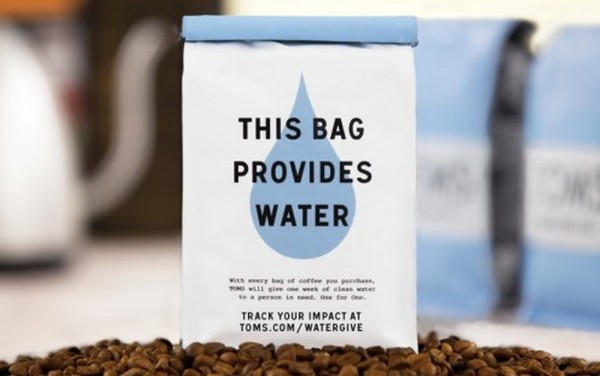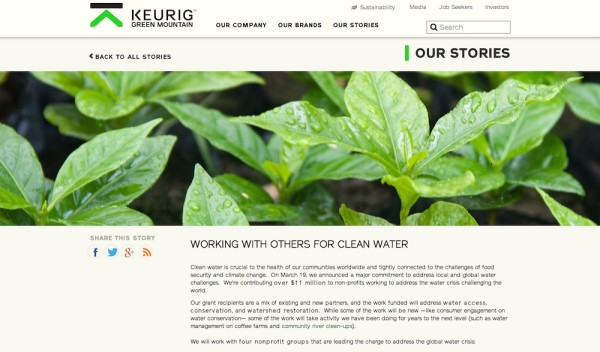by Michael Sheridan of CRS Coffeelands Blog
I have been doing a lot of thinking over the past few weeks as a result of all the coverage of water issues in coffee media — not on water so much as the nature of international development work. I am reminded that, in the words of a former colleague, the “how” of what we do may matter even more than the “what.”
Keurig Green Mountain and TOMS, the two corporations whose water investments have been the subject of the most discussion on this blog and elsewhere in the media, are both partnered with the non-profit Water for People. The what of the work each company is funding, in other words, is similar. The companies are oceans apart, however in how they are communicating their respective commitments.
(more: Toms Shoes Founder Blake Mycoskie Goes Big with New Coffee Venture)
How Matters
Jennifer Lentfer is a former CRS colleague and author of How Matters, a hugely influential blog on international aid whose tagline says it all: “Aid effectiveness is not about what we do, but HOW we do it.”
Her coverage addresses how international aid organizations relate to the people who participate in their programs and the people who work for them. She doesn’t spill as much ink on the issue of how they communicate their work to external audiences, but the blog itself — as well as Jennifer’s “day jobs” as the editor of Oxfam’s Politics of Poverty blog and adjunct professor at Georgetown’s Center for Social Impact Communication — suggests that effective communication is an important part of getting how right.
(more: Green Mountain Coffee Roasters Joins The Sustainability Consortium)
My personal feeling is that international development, at its best, is not something that professionals like me, whose salaries are paid by aid organizations, go off and do in isolation in remote places around the world. When international development is really working, the organizations that are funding it are are not just working on the ground, but also communicating broadly, thoughtfully and transparently: about the challenges and opportunities they see through their work; about both the successes and the failures of their programming; and about the kinds of investments likely to succeed and those likely to fail. Why? Because truly transforming the conditions that inhibit human development in far-off places requires changes closer to home — changes to public-sector policies and private-sector practices that are informed by a nuanced understanding of what is really happening on the ground.
We may do great work in the field that really unlocks the potential of a small number of people who participate in our projects, but if we fail to communicate our experience, analysis and recommendations, we miss opportunities for broader impact. In the end, what we communicate through and as a result of our programming may be more important to more people than the programming itself.
One approach, two communications strategies
What does this have to do with TOMS and Keurig Green Mountain? A lot, in my mind, since they have chosen similar whats but dissimilar hows, and their hows aren’t created equal.
Let’s start with the what. TOMS and Keurig Green Mountain have both partnered with Water for People, an enormously well-regarded non-profit organization working effectively around the world to empower communities to protect water resources and ensure the supply and quality of water. The Water for People work that these companies are committing to fund with the profits they earn from your business will similar and have similar impacts on people and the planet.
But the companies have chosen very different ways to communicate around this work.
TOMS
TOMS seems to apply a sponsorship approach that has largely fallen out of favor in international development work. Instead of asking you to sponsor a hungry child through a monthly contribution, TOMS asks you to sponsor a thirsty one through your purchase of a bag of coffee. The approach through which Water for People will turn TOMS contributions into water access is proven; the way TOMS is presenting its 1-for-1 on water doesn’t communicate the richness of that approach, and may raise more questions than answers. I have fielded some of these questions off-line since I published my earlier posts on the TOMS water 1-for-1 model:
- What does it mean to deliver one week of water to a person in need? How do you produce a week’s worth of water?
- What if a household has 11 people? Does my purchase only deliver water to one of them? Who decides which person gets the water and how do they decide?
- What happens if I order the TOMS “Malawi Roast” and don’t like it? If I stop buying it, does “my” person in need lose access to water?
- How do I reconcile the TOMS commitment of one week of water for one person with its own language on “long-term solutions” or with “Everyone Forever,” the visionary slogan of Water for People?
- How do I square the TOMS idea of “local ownership” of water with the idea that its access to water depends on my purchase of TOMS coffee?
In the end, I am delighted TOMS is partnering with such a strong nonprofit to fulfill its 1-for-1 commitment. I just wonder whether it is missing an opportunity to use its considerable platform to foster deeper understanding and elevate the tenor of the discussion.
Keurig Green Mountain
In comparison with the sleek TOMS campaign, the Keurig Green Mountain Water Policy is downright clunky — and endlessly more illuminating.
It talks about water challenges in the coffeelands in language that is more recongizable to the folks working in the field to address them. Its describes its programming and partnerships with organizations like Water for People that in ways that tell consumers more about how water is actually delivered and how water resources are actually protected. It takes a more holistic view of water work, identifying the integral link between improved water resource management and another thorny issue the company has wrestled with publicly–food security in the coffeelands.
Keurig Green Mountain has chosen a different how than TOMS. In my mind, it is one that is more likely to enlighten and inform.
Or maybe I just identify with it more because it sounds more like the development jargon I am used to reading.
Michael Sheridan
Michael Sheridan is the Chief Executive Officer of the Coffee Quality Institute, a nonprofit organization with a mission to improve coffee quality and the lives of those who produce it. Sheridan has been leveraging market forces to make coffee work for smallholder farmers and farm workers since 2004. Most recently he directed progressive green coffee sourcing activities and direct-trade partnerships at Intelligentsia Coffee. Prior to that he worked to deliver initiatives in the coffee sector in Central and South America on behalf of Catholic Relief Services.
Comment
1 Comment
Comments are closed.








So very interesting. Thanks for bringing this topic up! I wrestle with it everyday. My degree is in international development; however, I have spent most of my career as a storyteller – documentaries in fact. As of late, I have moved into the sphere of communication and marketing for clients that focus on causes and development. One of the first questions a documentary funder will ask a filmmaker is – who is your audience? The same question applies to TOMS and Green Mountain. TOMS is going for the general population – and perhaps even a hipster population – an audience that does not have a job in international development nor perhaps has much understanding of the complexity of the coffee industry and/or issues of poverty. They need simple, fast messages. Green Mountain is going for an audience that is willing to dive deeper – that will take the time to ask the complex questions and be comfortable with the grey issues. I tend to favor TOMS marketing, only because it is flashy and maybe more people will notice. But my heart and soul lies with the Green Mountain approach. Ideally, a bit of both would be best. A surface message for the masses, with the option to dive deeper. I think OXFAM AMERICA does a good job at balancing this kind of mixed approach.